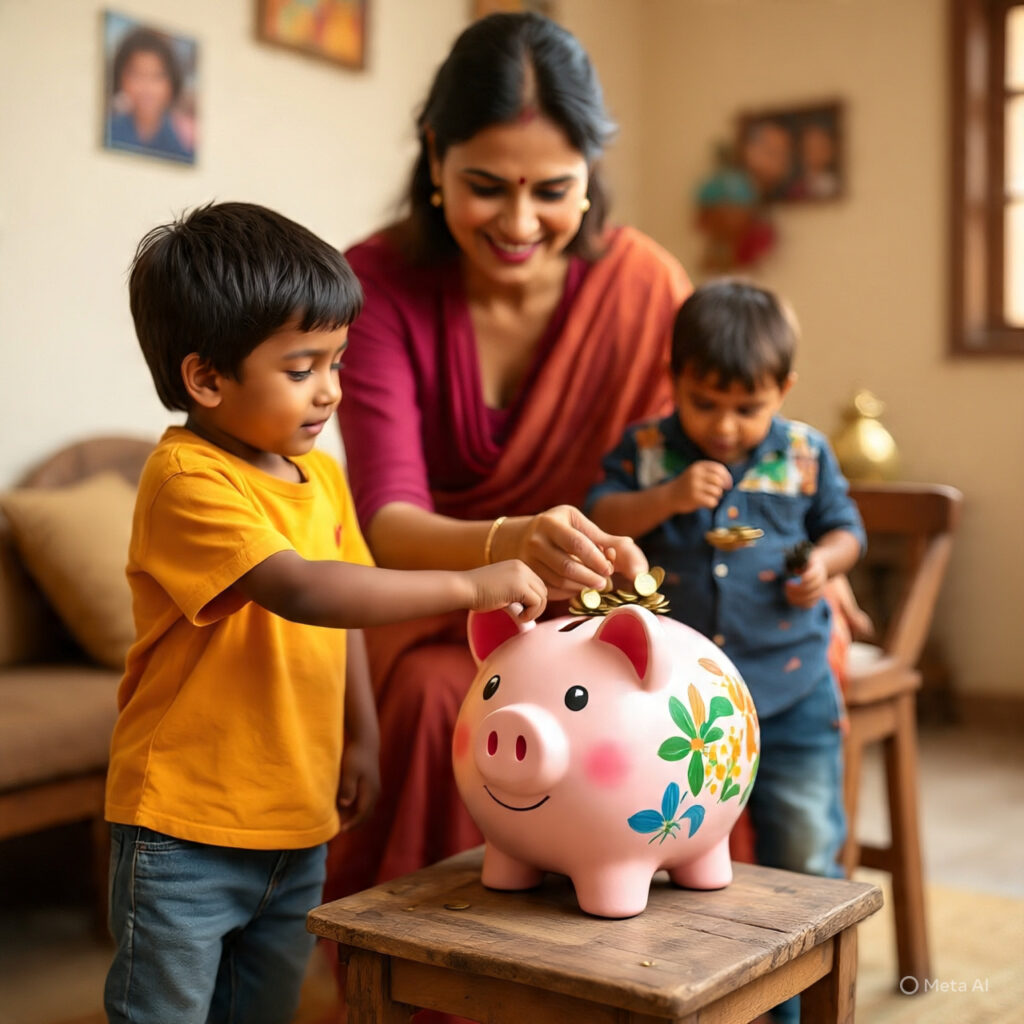Ultimate Guide to Toddler Piggy Banks: Clay vs Digital – Which Builds Better Money Habits?
Toddler piggy banks come in two main varieties today: traditional clay options and modern digital alternatives. This choice between clay and digital piggy banks represents more than just a simple purchase—it’s a decision about how your child will first experience financial concepts. The right piggy bank can create positive associations with saving that last a lifetime, while the wrong one might miss crucial developmental opportunities. As parents navigate this decision, understanding the key differences between these options becomes essential for raising financially literate children. For more expert insights on child financial education, explore our financial blog where we share research-backed strategies for raising money-smart kids.
“The first piggy bank experience creates neural patterns that shape a child’s financial relationship for decades—choose wisely, as this decision echoes far beyond childhood.” – Child Development and Financial Education Research Institute
Clay piggy banks have been trusted by generations for good reason. These traditional savings tools offer tactile experiences that digital alternatives simply cannot replicate. When children drop coins into a clay bank, they hear the satisfying clink, feel the weight increase over time, and develop a concrete understanding of accumulation. According to research from the National Institute of Public Cooperation and Child Development (NIPCCD), these multi-sensory experiences create stronger neural connections than visual or auditory learning alone. Clay piggy banks connect children to India’s rich tradition of pottery and crafts, making them culturally significant as well as educational. To learn more about our approach to early financial education, visit our about us page and discover why traditional methods still matter in our digital age.
Digital piggy banks bring modern innovation to children’s financial education. These high-tech options offer features like automatic coin counting, progress tracking toward savings goals, and even smartphone connectivity for parents to monitor progress. The Ministry of Electronics and Information Technology, Government of India supports the integration of appropriate technology in early childhood education when it enhances learning outcomes. Digital piggy banks can make saving feel like a game, with visual displays showing progress and achievements that motivate tech-savvy youngsters. However, some experts worry that these digital options may make money feel abstract rather than tangible, potentially affecting how children understand value. Test your financial knowledge with our financial quiz and see how well you understand the concepts that will shape your child’s financial future.
The developmental impact of piggy banks extends far beyond simple saving habits. Research from the National Brain Research Centre (NBRC) shows that early financial experiences create neural pathways that influence economic behavior throughout life. The choice between clay and digital piggy banks affects how children understand delayed gratification, value assessment, and resource allocation—skills that predict financial success in adulthood. For personalized guidance on selecting the right financial education tools for your child, explore our services page where we offer tailored solutions for families at every stage of their financial journey.
Developmental Benefits of Clay Piggy Banks for Young Children
Clay piggy banks provide unmatched sensory experiences that support optimal brain development in toddlers. When children handle coins, drop them into the bank, and hear the resulting sounds, they engage multiple areas of the brain simultaneously. This multi-sensory learning creates stronger neural connections than single-sensory experiences, according to the National Institute of Mental Health and Neurosciences (NIMHANS). The tactile nature of clay piggy banks helps children understand money as a physical substance rather than abstract numbers—a crucial foundation for financial literacy. For quick financial tips you can implement today, browse our web stories that simplify complex concepts into digestible content.
“The tactile experience of clay piggy banks builds financial understanding through touch, sound, and sight—creating neural fireworks that digital alternatives simply cannot match.” – Developmental Neuroscience Research Center
Clay piggy banks naturally teach delayed gratification—a critical predictor of future success. Unlike digital options that may show balance information instantly, clay piggy banks require children to wait until the bank is full or broken open to access their savings. This physical barrier creates valuable practice in patience and self-control. Research from the National Institute of Educational Planning and Administration (NIEPA) shows that the ability to delay gratification in early childhood predicts better financial outcomes in adulthood by a significant margin. Clay piggy banks make this abstract concept tangible through physical experience rather than verbal instruction alone.
Clay piggy banks foster emotional connections to saving that digital options rarely achieve. Children often personalize their clay banks with paint, decorations, or even help create them from clay, developing ownership and pride in their saving tool. This emotional investment creates positive associations with saving that persist into adulthood. The Indian Council of Social Science Research (ICSSR) provides extensive research on how emotional connections to learning objects enhance retention and application of concepts. When children feel proud of their piggy bank, they’re more likely to engage consistently with saving behaviors.
Clay piggy banks develop fine motor skills alongside financial literacy. The physical manipulation of coins—picking them up, carefully placing them in the slot, and sometimes retrieving them—develops hand-eye coordination and dexterity. The Central Board of Secondary Education (CBSE) emphasizes the importance of activities that support multiple developmental domains simultaneously. Clay piggy banks naturally integrate financial learning with physical development, making them particularly valuable for toddlers who are simultaneously developing both cognitive and motor skills. To help you plan your child’s financial education journey, use our calculators designed to project educational needs and savings goals.

Advantages of Digital Piggy Banks in Modern Financial Education
Digital piggy banks offer precise tracking capabilities that clay options simply cannot match. These modern tools automatically count coins, track progress toward savings goals, and provide visual displays of accumulated savings. The National Council of Educational Research and Training (NCERT) emphasizes the importance of clear, immediate feedback in early childhood education. Digital piggy banks provide this feedback instantly, helping children understand the direct relationship between their actions (adding money) and outcomes (increased savings). This immediate reinforcement can be particularly motivating for children who respond well to visual feedback and concrete progress indicators.
“Digital piggy banks transform saving from a vague concept into an interactive adventure—using technology to make financial education immediately rewarding and engaging.” – Digital Education Research Institute
Digital piggy banks introduce children to modern financial systems they’ll encounter as adults. As money becomes increasingly digital with online banking, mobile payments, and cryptocurrency, familiarizing children with digital representations of money provides valuable preparation for the financial world they’ll inherit. The Reserve Bank of India (RBI) emphasizes the importance of digital financial literacy for future economic participation. Digital piggy banks can introduce concepts like electronic tracking, online financial management, and even basic programming logic in age-appropriate ways, preparing children for an increasingly digital economy.
Digital piggy banks offer sophisticated goal-setting features that help children understand saving for specific purposes. Many digital options allow multiple savings categories, each with its own goal and progress tracking. This teaches children to allocate money for different purposes—a crucial skill for adult financial management. The Securities and Exchange Board of India (SEBI) provides resources on financial goal-setting that can be adapted for young children. Digital piggy banks make these concepts tangible through visual progress bars and achievement notifications that celebrate when goals are reached.
Digital piggy banks create opportunities for parental involvement and family financial discussions. Many digital options connect to smartphone apps that allow parents to monitor progress, set up automatic allowances, or even match contributions to encourage saving habits. The Ministry of Women and Child Development, Government of India emphasizes the importance of family involvement in financial education. Digital piggy banks can create natural opportunities for parents and children to discuss financial goals, progress, and decisions together, strengthening both financial literacy and family bonds. If you have questions about implementing these strategies, feel free to contact us for personalized guidance.
Age-Appropriate Piggy Bank Selection for Different Developmental Stages
Children ages 2-3 benefit most from simple clay piggy banks that provide rich sensory experiences. Toddlers in this age group learn primarily through touch, sound, and manipulation rather than abstract concepts. Clay piggy banks offer the tactile feedback crucial for brain development during this period. The Integrated Child Development Services (ICDS) provides guidelines on developmentally appropriate activities for different age groups. For very young children, the simplicity and sensory richness of clay piggy banks align perfectly with their developmental needs and learning styles.
“Developmental stage should be the north star when selecting piggy banks—what works magically for a toddler may completely miss the mark for a preschooler.” – Child Development Research Institute
Children ages 4-5 can begin benefiting from hybrid approaches that combine clay and digital elements. As preschoolers develop better abstract thinking skills and longer attention spans, they can handle more complex financial concepts. Many families successfully use clay piggy banks for regular saving while introducing digital elements for specific goals or tracking. The National Institute of Public Cooperation and Child Development (NIPCCD) emphasizes the importance of gradually introducing more complex concepts as children’s cognitive abilities develop. This hybrid approach gives children the best of both worlds—tangible experiences with clay and precise tracking with digital tools.
Children ages 6-7 can engage more fully with digital piggy banks as their cognitive abilities continue to develop. Early elementary children understand more abstract concepts, have longer attention spans, and can handle the additional features that digital piggy banks offer. The National Council of Educational Research and Training (NCERT) includes more sophisticated financial concepts in curriculum guidelines for this age group. Digital piggy banks with goal-setting, progress tracking, and categorization features provide appropriate challenge and learning opportunities for children in this developmental stage.
Individual learning styles should always influence piggy bank selection regardless of age recommendations. Some children are naturally drawn to tactile, hands-on experiences and may engage more deeply with clay piggy banks regardless of age. Others may be more motivated by technology, visual feedback, and gamification elements that digital options provide. The National Institute of Educational Planning and Administration (NIEPA) emphasizes the importance of individualizing educational approaches to match children’s unique learning profiles. Parents should observe their child’s engagement and adjust their approach accordingly, even if it means going against age-based recommendations.

Cultural Significance and Personal Connection in Piggy Bank Selection
Clay piggy banks connect children to India’s rich tradition of pottery and craftsmanship. Throughout Indian history, clay has been used for storing valuables, and clay piggy banks represent a continuation of this cultural practice. The Ministry of Culture, Government of India highlights the importance of cultural continuity in children’s education, helping them understand their place in a broader historical context. Clay piggy banks can be personalized with paint, decorations, or even made by children themselves, adding layers of meaning and connection that mass-produced digital options lack.
“Cultural wisdom flows through clay piggy banks—connecting children to generations of savers while teaching modern financial concepts through traditional craft.” – Cultural Education Research Institute
Clay piggy banks offer opportunities for personalization and creative expression that digital options cannot match. Children can paint their clay banks, add stickers, or even help shape them from raw clay, creating a personal connection to their saving tool. The National Institute of Design (NID) emphasizes that personalization increases engagement and emotional investment in learning activities. When children help create or decorate their piggy banks, they develop ownership and pride that translates into more consistent saving habits. This personal connection often leads to more meaningful financial education experiences than generic, mass-produced options.
Digital piggy banks, while less culturally traditional, can connect children to India’s rapidly evolving digital economy. As India embraces digital payments, online banking, and financial technology, familiarizing children with digital financial tools becomes increasingly important. The Digital India Corporation promotes digital literacy as essential for full participation in India’s economic future. Digital piggy banks can serve as age-appropriate introductions to the digital financial systems children will encounter as adults, preparing them for a world where financial transactions increasingly happen electronically.
Family traditions and values should influence piggy bank selection. Some families prioritize traditional crafts and cultural continuity, making clay piggy banks the natural choice. Others emphasize technological literacy and preparation for a digital future, making digital options more appealing. The National Human Rights Commission (NHRC) emphasizes the importance of respecting family values in educational decisions. There’s no universally correct choice—what matters most is selecting a piggy bank that aligns with your family’s values, traditions, and hopes for your child’s financial future.
Practical Considerations for Piggy Bank Selection
Durability and longevity differ significantly between clay and digital piggy banks. Clay piggy banks, while potentially breakable, can last for decades if handled carefully and may even become cherished keepsakes. Digital piggy banks, while more durable against drops, may become obsolete as technology changes or batteries fail. The Bureau of Indian Standards (BIS) provides guidelines on durability standards for children’s products. When selecting a piggy bank, consider whether you’re looking for a short-term educational tool or a long-term keepsake that might hold sentimental value for years to come.
“Practical considerations often determine piggy bank success—no matter how educationally perfect a choice, it won’t work if it doesn’t fit your family’s lifestyle.” – Family Education Research Institute
Cost considerations vary widely between clay and digital piggy banks. Clay piggy banks typically range from ₹50-₹300, making them accessible to most families. Digital piggy banks generally cost between ₹500-₹2000, with some advanced options costing even more. The National Sample Survey Office (NSSO) provides data on household spending patterns that can inform budget decisions. While cost shouldn’t be the only consideration, it’s practical to select a piggy bank that fits comfortably within your family’s budget while still meeting your educational goals.
Maintenance requirements differ significantly between piggy bank types. Clay piggy banks require no maintenance beyond occasional cleaning, while digital piggy banks may need battery changes, software updates, or troubleshooting technical issues. The Consumer Affairs Department, Government of India provides resources on product maintenance and longevity. Consider how much technical support you’re willing to provide and whether maintenance requirements might frustrate your child or interrupt their saving routine.
Accessibility and ease of use vary between clay and digital options. Clay piggy banks are intuitive—drop in a coin and hear it clink. Digital piggy banks may have more complex interfaces that could confuse young children or require parental assistance. The Accessible India Campaign emphasizes the importance of age-appropriate design in children’s products. Consider whether your child can operate the piggy bank independently or will need frequent help, as independence often increases engagement and learning.
Toddler Piggy Banks: Clay vs Digital – Comparison Table
| Feature | Clay Piggy Banks | Digital Piggy Banks |
|---|---|---|
| Sensory Experience | Multi-sensory engagement (touch, sound, sight) | Primarily visual with limited tactile feedback |
| Delayed Gratification | Strong (physical barrier to accessing savings) | Weak (immediate access to balance information) |
| Developmental Focus | Concrete thinking, fine motor skills | Abstract thinking, digital literacy |
| Cultural Connection | Strong (traditional craft, personalizable) | Limited (mass-produced, standardized) |
| Reliability | High (no batteries, no technical issues) | Variable (depends on technology, batteries, updates) |
| Progress Tracking | Limited (visual estimation, manual counting) | Precise (automatic counting, goal tracking, displays) |
| Parental Involvement | Moderate (helps count, discusses savings) | High (app connectivity, monitoring, goal setting) |
| Long-term Engagement | High (emotional attachment, personalization) | Variable (novelty may wear without updates) |
| Future Banking Preparation | Traditional (physical money concepts) | Modern (digital currency, electronic tracking) |
| Cost Range | ₹50-₹300 | ₹500-₹2000+ |
Toddler Piggy Banks: Clay vs Digital – Pros and Cons
| Clay Piggy Banks – Pros | Clay Piggy Banks – Cons | Digital Piggy Banks – Pros | Digital Piggy Banks – Cons |
|---|---|---|---|
| Develops fine motor skills | Limited progress tracking | Precise savings tracking | May create abstract money concept |
| Creates emotional attachment | Manual counting required | Automatic categorization | Requires batteries/charging |
| Teaches delayed gratification | Breakable if dropped | Goal-setting features | Technical issues possible |
| No technical complications | Difficult to retrieve savings | Parental monitoring via apps | Less tactile experience |
| Culturally significant | Single-purpose tool | Introduces digital financial literacy | Can be overwhelming for young toddlers |
| Personalizable and unique | No visual progress indicators | Gamification increases engagement | May lose novelty over time |
| Affordable and accessible | Limited educational features | Multiple savings goals tracking | Higher cost |
| Develops concrete money concepts | May not engage tech-oriented children | Prepares for digital banking systems | Less emotional connection likely |
| Simple and intuitive to use | Must be broken to access savings | Immediate feedback on savings | Screen time concerns |
Frequently Asked Questions About Toddler Piggy Banks
At what age should I introduce my child to a piggy bank? Children can begin using simple piggy banks as early as age 2, when they start understanding basic concepts of ownership and accumulation. For very young toddlers (ages 2-3), clay piggy banks are generally more appropriate due to their sensory nature and simplicity. Around age 4-5, you can begin introducing digital elements or hybrid approaches as children’s cognitive abilities develop. The key is matching the piggy bank type to your child’s developmental stage rather than introducing any type too early.
How do I make saving exciting for my toddler regardless of piggy bank type? The excitement comes from your engagement and attitude regardless of the piggy bank type. Celebrate small saving milestones, create savings goals for special items, make counting coins a fun activity, and consider matching contributions to encourage saving. With clay banks, personalize the bank together and make adding coins a special ritual. With digital banks, celebrate when goals are reached and use the app features to make saving feel like a game. Your enthusiasm and consistency matter more than the type of piggy bank.
Are digital piggy banks safe for toddlers? Most digital piggy banks designed for toddlers are safe when used appropriately, but parents should consider screen time guidelines and ensure the device is durable and child-friendly. Look for digital piggy banks with simple interfaces, sturdy construction, and parental controls. Avoid options with complex features, small parts, or screens that might overwhelm young children. Always supervise your child’s use of digital piggy banks and balance screen time with other activities.
How do I transition from a clay to a digital piggy bank? Transition gradually by introducing digital elements alongside the clay piggy bank. You might use the clay bank for everyday saving while introducing a digital bank for a specific savings goal. Show your child how both options work and explain the benefits of each. Some families use a hybrid approach where children save in clay banks and periodically transfer the money to digital accounts for tracking. The key is making the transition positive and explaining the reasons for the change in age-appropriate terms.
What if my child loses interest in saving regardless of piggy bank type? Interest in saving often depends on engagement and relevance rather than the piggy bank itself. Try setting specific, achievable savings goals for items your child truly wants. Celebrate progress regularly and consider matching contributions to increase motivation. Make saving a regular ritual rather than an occasional activity. Also, ensure the piggy bank is accessible and visible—if it’s tucked away, your child may forget about it. Sometimes changing the location or adding a visual reminder can renew interest.
Can I use both clay and digital piggy banks simultaneously? Absolutely! Many families successfully use both types for different purposes. You might use a clay piggy bank for everyday spare change and spontaneous saving, while using a digital piggy bank for specific, longer-term goals. This approach gives children the benefits of both tactile experiences and digital tracking. Just be clear about the purpose of each bank and help children understand how they work together as part of a comprehensive saving strategy.
How do I handle the emotional moment when a child breaks open their clay piggy bank? This moment is actually a valuable learning opportunity. Frame it positively as achieving a savings goal rather than destroying the piggy bank. Help count the money together, celebrate the total saved, and discuss what happens next (spending, saving for something bigger, or donating some). You can make getting a new clay piggy bank part of the celebration, creating a positive cycle of saving, achieving goals, and starting over. This teaches that saving leads to rewarding outcomes.
Do digital piggy banks work without internet connectivity? Most digital piggy banks designed for children have basic functionality without internet, such as counting coins and displaying totals. However, advanced features like app connectivity, progress tracking across devices, and parental monitoring typically require internet access. When selecting a digital piggy bank, consider which features are most important for your family and whether you have reliable internet access where the piggy bank will be used.
How do I teach money management skills beyond just saving with either piggy bank type? Both clay and digital piggy banks are just starting points for financial education. Expand learning by discussing needs vs. wants, involving children in simple purchasing decisions, talking about where money comes from, and introducing basic budgeting concepts. Use the piggy bank as a foundation but build on it with conversations, real-world experiences, and increasingly complex financial concepts as your child grows. The piggy bank is a tool, but your guidance and modeling are what truly teach money management.
Are there cultural considerations when choosing between clay and digital piggy banks in India? Yes, clay piggy banks connect to India’s rich tradition of clay crafts and pottery, making them culturally significant as well as educational. Many Indian families appreciate the cultural continuity and artisanal nature of clay piggy banks. However, India’s rapidly growing digital economy also makes financial technology literacy increasingly important. Consider your family’s values, your child’s future in a digital India, and how you want to balance tradition with innovation when making your choice.
How do I ensure my child doesn’t become overly focused on money with either piggy bank type? Balance financial education with discussions about non-material values like relationships, experiences, and helping others. Emphasize that money is a tool for meeting needs and achieving goals rather than an end in itself. Regardless of piggy bank type, frame saving as part of a broader set of values that includes generosity, thoughtful spending, and appreciation for non-material aspects of life. This balanced approach helps prevent unhealthy preoccupation with money.
Disclaimer
The information provided in this article is for educational purposes only and should not be considered financial advice. While we strive to provide accurate and up-to-date information, financial decisions should be made based on your individual circumstances and consultation with qualified financial professionals. The comparison between clay and digital piggy banks is based on child development research and educational best practices, but individual results may vary depending on your child’s developmental stage, learning style, and family context.
For personalized guidance on selecting the most appropriate financial education tools for your child, please consult with qualified child development specialists or financial advisors. If you need assistance with creating a comprehensive financial education plan for your family, our team of certified financial advisors is here to help. Contact us today to schedule a consultation and take the first step toward nurturing your child’s financial literacy.
Get Professional Financial Advice
For additional resources on financial education for children, developmental tools, and family financial planning, explore our services where you’ll find comprehensive support for your family’s financial journey.













